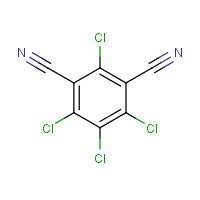Chlorothalonil
Agent Name
Chlorothalonil
CAS Number
1897-45-6
Formula
C8-Cl4-N2
Major Category
Pesticides

Synonyms
Forturf; Bravo; Exotherm; m-TCPN; Sweep; TCIN; Termil; TPN; Daconil; 2,4,5,6-Tetrachloro-1,3-Benzenedicarbonitrile, 2,4,5,6-tetrachloro-; 1,3-Dicyanotetrachlorobenzene; 2,4,5,6-Tetrachloro-1,3-benzenedicarbonitrile (8CI)(9CI); 2,4,5,6-Tetrachloro-3-cyanobenzonitrile; 2,4,5,6-Tetrachloroisophthalonitrile; Bravo; Bravo 500; Bravo 6F; Bravo-W-75; Chloroalonil; Chlorthalonil [German]; Clorthalonil [German]; Clortocaf ramato; Clortosip; DAC 2787; Daconil; Daconil 2787; Daconil 2787 W-75 Fungicide; Daconil 2787 W75; Daconil 2787 flowable fungicide; Daconil Flowable; Daconil M; Dacosoil; Exotherm; Exotherm termil; Faber; Forturf; Isophthalonitrile, 2,4,5,6-tetrachloro-; Nopcocide; Nopcocide N-96; Nopcocide N40D & N96; Repulse; Sweep; TPN (pesticide); Termil; Terraclactyl; Tetrachlorisoftalonitril [Czech]; Tetrachloroisophthalonitrile; m-TCPN; m-Tetrachlorophthalonitrile; meta-TCPN; meta-Tetrachlorophthalodinitrile; Isophthalonitrile, tetrachloro-; [ChemIDplus] UN2588
Category
Fungicides
Description
Colorless or white odorless solid; [HSDB] White solid; Formulated in the form of dust, granular, wettable powder, dry flowable, flowable concentrate, impregnated material, and ready-to-use; [Reference #2]
Sources/Uses
Used as a fungicide on vegetables, trees, fruits, turf, ornamentals, and other crops; [EXTOXNET] Used as a fungicide and preservative in paints, adhesives, and wood; [Kanerva, p. 786] Used as a biocide in paint; [Adams, p. 475] Used as a preservative in adhesives; [HSDB] Act mainly as a fungicide and mildewicide, but possesses some bactericidal, microbicidal, algaecidal, insecticidal, and acaricidal properties; Used as broad spectrum non-systemic pesticide, mildewicide for paints and other surface treatments, and protectant for wood; Contains hexachlorobenzene (HCB) as an impurity; [Reference #2]
Comments
No cases of systemic poisoning have been documented, but allergic contact dermatitis has been reported. [EPA Pesticides] Occupational asthma reported in farmer; [Malo] It is a strong skin irritant; Allergic contact dermatitis reported in flower and vegetable growers and carpenters; [Kanerva, p. 786] Chlorothalonil can cause immunologic, occupational contact urticaria. [Kanerva, p. 219] A severe eye, mild skin, and respiratory tract irritant; May cause skin sensitization; [ICSC] Reports of contact dermatitis in agricultural workers, cabinet makers, and employees of a chlorothalonil manufacturing facility; Occupational asthma also reported; Workers in a packaging plant reported intense pain on ocular exposure; Moderate conjunctivitis and corneal irritation (no corneal opacity) were observed; [HSDB] A mild skin irritant; Can cause permanent eye injury; A weak skin sensitizer; [Syngenta MSDS]
Biomedical References
Exposure Assessment
Vapor Pressure
5.7E-07 mm Hg
Lethal Concentration
LC50 (rat) = 92 mg/m3
Explanatory Notes
The Guide in the Emergency Response Guidebook is for "Pesticide, solid, toxic, n.o.s." VP from HSDB;
Reference Link #2
Adverse Effects
Skin Sensitizer
Yes
Asthma
Yes
IARC Carcinogen
Possible (2b)
Diseases, Processes, and Activities Linked to This Agent
Diseases
Occupational diseases associated with exposure to this agent:
Processes
Industrial Processes with risk of exposure: